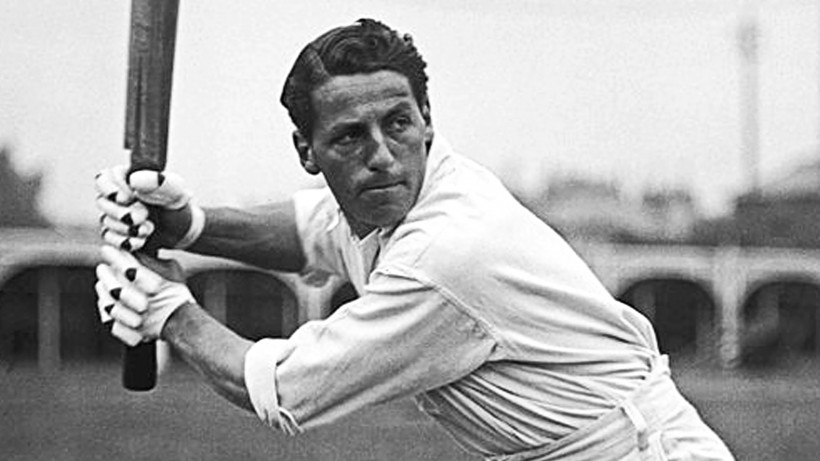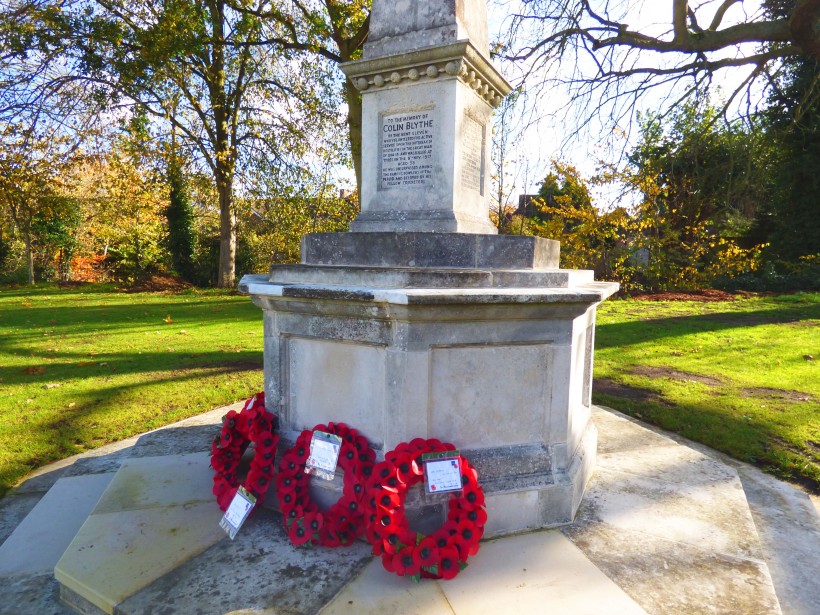Kent Remembers: Kenneth Hutchings
Monday 9th November 2020

Born: 7.12.1882, Southborough. Died: 3.9.1916, Ginchy, France.
Kent 1902-1912. Kent cap (no.60), 1903.
Tests: Seven for England.
Wisden Cricketer of the Year, 1907.
More perhaps than any other cricketer, Kenneth Hutchings epitomised all that was best in Kent cricket in the years leading up to the First World War.
His was a short career, in essence only half a dozen seasons, but in that time he was the idol of the Kentish faithful – and looked the part – before his untimely death in August 1916 during the Battle of the Somme.
Seeking to dominate the bowling from the first ball, if Wisden has its timings right, at least twelve of his 22 centuries were scored at more than a run a minute. To the Daily Telegraph, he was ‘the most engaging batsman of his day’.
Gifted with immensely powerful wrists and forearms, such was the power of his cutting and driving that even the best fielders retreated yards deeper when he arrived at the wicket.
Writing in 1938 at the end of his long career, Frank Woolley considered Hutchings ‘the hardest driver I ever saw, bar nobody’. Five outfielders were not uncommon when he was at his best. His straight driving made pavilion windows and fascia boards a poor insurance risk; one of his drives into the top of the Pavilion at Canterbury broke his mother’s wrist watch.
Although some critics thought he overdid it, on the leg side he excelled in the pull which, with better pitches, had recently become fashionable but his great glory was his shot to a good length ball on middle and leg. This he would despatch like a ‘a gunshot’ to the boundary anywhere between backward square leg and wide mid on with what was, to all appearances, a mere flick of the wrists.
With Jack Mason, Jim Seymour and Dick Blaker, Kent were well stocked with slip fielders but none were thought to excel Hutchings. In 1907 he exceeded a catch a match (26 in 23) and did the same in the MCC tour of Australia that winter (23 in 17).
Equally, he was one of the finest outfielders of his time with a powerful throw, derived, it was said, from wrist alone. According to Kent historian Bill Arrowsmith, once, while reclining in a deck chair at Canterbury, he threw to the far wicket without changing position. On another occasion, for a wager, he threw, from a standing position at the Nackington Road End wicket, into the top tier of the pavilion six times in succession. For an encore, taking a short run, he threw over the pavilion. As a bowler, he lacked accuracy but had his days.
Youngest of four sons of a surgeon, all of whom played cricket for Tonbridge School, Kenneth Hutchings had cricketing antecedents. Kenneth Hutchings was in the Eleven at Tonbridge from 1898 (when he played under the captaincy of his brother William) to 1902 and led the side in his two final years.
Although fresh from school, Hutchings was more experienced than many young amateurs when, in August 1902, he made his first-class debut for Kent, v Worcestershire at Tonbridge.
1903 gave a hint of what was to come. On his second appearance in 1903 he hit 63 at Tunbridge Wells against a Lancashire attack including the great Sidney Barnes.
At Taunton, Kent were in trouble at 83 for five when he joined Mason. Together they took the score to 248 for six, Hutchings smiting 106 in 85 minutes with 19 fours. On a wet wicket at Bournemouth, he revived a flagging innings with 84* in 100 minutes (ten fours) to set up an innings victory.
At the end of the season he was the youngest member of the Kent team who broke new ground for a county team by touring the USA.
At this stage in the young man’s career, real life began to intervene. Like all but the most fortunate, he was faced with the tiresome necessity of earning a living. Before he could embark on his expenses paid US tour, Kent had reimbursed a clergyman named Price with £6 in compensation for loss of his unspecified services. In 1904 business restricted him to just two Kent matches and only one in 1905.
As a result, Hutchings’ performance in 1906 came as a revelation to even the most knowledgeable followers of Kent cricket – 1,454 runs (avge.60.58) – 1,597 in all matches – with four hundreds and eleven half-centuries.
Unable to start until Tonbridge Week commencing 18 June, in the second match, facing a Middlesex total of 366, he came in with the score 117 for six. Missed before he had scored, he hit 125 in 130 minutes (one six, 19 fours), adding 105 in a ninth-wicket stand with a sciatica-smitten Fred Huish (17*). Kent needed 292 in their second innings and had declined to 136 for six when Hutchings arrived at the wicket. At the close they were 253 for nine. Hutchings, who spurned a last ball long hop in the interest of his side, 97*. Huish, batting with a runner and almost incapable of movement, finished 0*.
In the next match, v Yorkshire at Bramall Lane, Hutchings’ 131 (170 minutes) was one of only two centuries scored against the Yorkshire bowling that year and he broke three bats in the process. His 50* in the second innings saw Kent through to a draw.
Hutchings demolished another three bats in hitting 176 (27 fours) out of 312 against Lancashire in Canterbury Week, adding 213 for the fourth with Mason (88).
At Bournemouth he hammered the bowling for 124 (21 fours, one six), reaching his hundred in 65 minutes, and sharing a 180-run thirdwicket partnership with Burnup (79).
Hutchings hit four centuries in 1907, including another against Lancashire in Canterbury Week, but by the standards of 1906 it was an unremarkable season with 1048 runs (avge. 30.82) and only three other scores over 50.
Nevertheless, he had already done more than enough and he was invited to tour Australia with MCC.
On tour he took some time to adjust his technique to Australian wickets but in his second match, against Victoria, he hit 91 and in all first-class matches, only Joe Hardstaff scored more than his 953 runs (avge.34.03), with one hundred and six half-centuries
His 126 (one six, 25 fours) in the Second Test at Melbourne, was the first Test century by a current Kent cricketer.
In his account of the 1907/08 tour With the MCC in Australia , journalist turned tour manager Major Philip Trevor wrote of Hutchings ‘Finely as he batted, he made fame even more as a fieldsman. It is probably a sober, simple fact that Hutchings is the best catcher in the world’.
On his return to England, he passed his 1,000 runs, as he did in every season until 1912. If he never again quite matched his form of 1906, he continued to dominate bowlers and entertain spectators. Only twice did his average fall below 30.
His best seasons were 1910, 1,654 runs (avge. 41.95) and 1909, 1,697 runs (avge.36.30) with three centuries and eleven half-centuries. In 1909 he struck his fastest century, 100 in 50 minutes v Gloucestershire at Catford.
He scored a century against eleven of the then 16 first-class counties, four against Hampshire.
In 1909 England’s much maligned selectors called on Hutchings twice. At Old Trafford he was bowled by Frank Laver for nine in his only innings. At The Oval he joined Jack Sharp with England 206 for six. Together they steered England to the relative safety of 348 when both departed at the same total (Sharp 105, Hutchings a relatively sedate 59).
While finding time for occasional club games in the South – he played at least once for the Mote in 1913 – work took him first to Birmingham and while there he played a few games for Aston Unity in the Birmingham & District League. In 1913-1914 he was in Liverpool and appeared regularly for Formby in the Lancashire Premier League.
He continued to demolish club bowling with two centuries against Birkenhead Park, 146 in 100 minutes against Oxton and 90s against Rock Ferry and Sefton.
It was from Formby that Hutchings enlisted within a few weeks of the outbreak of the First World War and was commissioned into the Fourth Battalion King’s Regiment (Liverpool).
In April 1915 he was posted to France and on 2 May attached to the 2nd Battalion Royal Welch Fusiliers (19 Brigade), an ‘elite’ Regular Army unit immortalised by Robert Graves in Goodbye to All That, Siegfreid Sassoon in Memories of an Infantry Officer and JC Dunn and others in the definitive The War the Infantry Knew.
Second Lieutenant Hutchings had his first experience of the trenches within three days of his arrival and over the next four months saw a great deal of action. He was with the battalion when they took part in the bloody Battle of Loos. In October he underwent an operation and was eventually returned to England where he was attached to the 3rd (Reserve) Battalion of the King’s Regiment.
Promoted to Lieutenant, in July 1916 he returned to France, posted to his regiment’s 12th (Service) Battalion (61 Brigade, 20th Division.) who were in the line near Messines.
Moved to the Somme in August, following his Division’s capture of Guillemont, he lost his life near Ginchy on 3 September during a German counter-attack. He has no known grave. The obituary in Wisden refers to Lieutenant Hutchings having been ‘struck by a shell’.
Where the details of a soldier’s death were thought to have been too distressing, or, more often, were simply unknown, these words or ‘shot through the heart’ were frequently used by tactful commanding officers or adjutants.
Although Wisden’s obituarist thought Kenneth Hutchings ‘did not fulfil all the hopes formed for him’ and the Tunbridge Wells Courier used the words ‘unfulfilled promise’, this perhaps underestimates his very considerable contribution to Kent’s success between 1906 and 1914.
It was not merely the runs he scored but the rate at which he scored them although, in fact, of his Kent contemporaries, only Cuthbert Burnup had a better career average at the end of 1914. In addition to his 22 centuries and 56 half centuries, there were 66 scores between 25 and 49.
If, like some others who died in war, Kenneth Hutchings may have become something of a forgotten man, he deserves to be remembered.
His name is on the Thiepval Memorial, on the War Memorial in Southborough and on a cross outside St Peter’s Church, Formby which was originally erected outside Ginchy Advanced Dressing station by officers of his battalion.
In 2013 a plaque was placed on the wall of his former home at 71 London Road, Southborough. On his death his effects were valued at £559 12s 9d.
Profile adapted from Derek Carlaw’s ‘Kent County Cricketers: A to Z, 1806-1914’
Previous profiles of Kent Cricketers that fell during both World Wars include:
Colin Blythe
Gerry Chalk
Arthur Du Boulay
Eric Hatfeild
Kenneth Hutchings
David Jennings
Lawrence Le Fleming
Geoffrey Legge
Lionel Troughton
George Whitehead

